Transit of Mercury
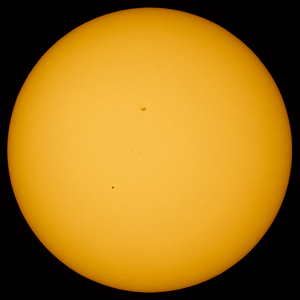
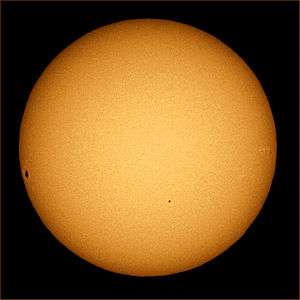
A transit of Mercury across the Sun takes place when the planet Mercury passes directly between the Sun and a superior planet, becoming visible against (and hence obscuring a small portion of) the solar disk. During a transit, Mercury appears as a tiny black dot moving across the disk of the Sun.
Transits of Mercury with respect to Earth are much more frequent than transits of Venus, with about 13 or 14 per century, in part because Mercury is closer to the Sun and orbits it more rapidly.
Transits of Mercury occur in May or November. The last four transits occurred on November 15, 1999; May 7, 2003; November 8, 2006; and May 9, 2016. The next will occur on November 11, 2019, and then on November 13, 2032. A typical transit lasts several hours.
On June 3, 2014, the Mars rover Curiosity observed the planet Mercury transiting the Sun, marking the first time a planetary transit has been observed from a celestial body besides Earth. [1]
More generally, transits can also occur for Venus[2] and were investigated in the context of searching for the hypothetical inner planet Vulcan.
Scientific observations
The most common observation to be made at a transit is to record the times when the disk of Mercury appears to be in contact with the limb of the Sun. Those contacts are traditionally referred to as the 1st, 2nd, 3rd and 4th contacts – with the 2nd and 3rd contacts occurring when the disk of Mercury is fully on the disk of the sun. As a general rule, 1st and 4th contacts cannot be accurately detected, while 2nd and 3rd contacts are readily visible within the constraints of the Black Drop effect, irradiation, atmospheric conditions, and the quality of the optics being used.
Observed contact times for transits between 1677 and 1881 are given in S Newcomb's analysis of transits of Mercury.[3] Observed 2nd and 3rd contacts times for transits between 1677 and 1973 are given in Royal Greenwich Observatory Bulletin No.181, 359-420 (1975).[4]
Examples of the scientific investigations based on transits of Mercury are:
- Investigations of the variability of the Earth's rotation and of the tidal acceleration of the Moon.[5][6][7]
- Measuring the mass of Venus from secular variations in Mercury's orbit.[3]
- Looking for long term variations in the solar radius.[8][9]
- Investigating the black drop effect, including calling into question the purported discovery of the atmosphere of Venus during the 1761 transit.[10][11][12]
- Assessing the likely drop in light level in an exoplanet transit.[13]
Images of the November 15, 1999 transit from the Transition Region and Coronal explorer (TRACE) satellite were on Astronomy Picture of the Day (APOD) on November 19[14] Three APOD's featured the May 9, 2016 transit.[15][16][17]
Occurrence of transits
Transits of Mercury can only occur when the Earth is aligned with a node of Mercury's orbit. Currently that alignment occurs within a few days of May 8 (descending node) and November 10 (ascending node), with the angular diameter of Mercury being about 12" for May transits, and 10" for November transits. The average date for a transit increases over centuries as a result of the longitude of the nodes of Mercury's orbit increasing by about 1.1 deg per century.
Transits of Mercury occur on a regular basis. As explained in 1882 by Newcomb,[18] the interval between passages of Mercury through the ascending node of its orbit is 87.969 days, and the interval between the Earth's passage through that same longitude is 365.254 days. From the ratio of these values, it can be easily shown that Mercury will make an almost integral number of revolutions about the Sun over intervals of 4, 6, 7, 13, 33, 46, 171 and 217 years.
In 1894 Crommelin [19] noted that at these intervals, the successive paths of Mercury relative to the Sun are consistently displaced northwards or southwards. He noted the displacements as:
Displacements at subsequent transits
| Interval | May transits | November transits |
|---|---|---|
| After 6 years | 65’ 37" S | 31' 35" N |
| After 7 years | 48’ 21" N | 23' 16" S |
| Hence after 13 years (6+7) | 17’ 16" S | 8’ 19" N |
| ... 20 years (1x6 + 2x7) | 31’ 05" N | 14’ 57" S |
| ... 33 years (2x6 + 3x7) | 13’ 49" N | 6’ 38" S |
| ... 46 years (3x13 + 7) | 3’ 27" S | 1’ 41" N |
| ... 217 years (14x13 + 5x7) | 0’ 17" N (nowadays, see talk) | 0’ 14" N (nowadays, see talk) |
Comparing these displacements with the solar diameter (about 31.7’ for May, and 32.4’ for November, transits) the following may be deduced about the interval between transits:
- For May transits, intervals of 6 and 7 years are not possible. For November transits, an interval of 6 years is possible but rare (the last such pair was 1993 and 1999), while an interval of 7 years is to be expected.
- An interval of 13 years is to be expected for both May and November transits.
- An interval of 20 years is possible but rare for a May transit, but is to be expected for November transits.
- An interval of 33 years is to be expected for both May and November transits.
- A transit having a similar path across the sun will occur 46 (& 171) years later – for both November and May transits.
- A transit having an almost identical path across the Sun will occur 217 years later – for both November and May transits.
Transits that occur 46 years apart can be grouped into a series. For November transits each series includes about 20 transits over 874 years, with the path of Mercury across the Sun passing further north than for the previous transit. For May transits each series includes about 10 transits over 414 years, with the path of Mercury across the Sun passing further south than for the previous transit. Some authors[20] have allocated a series number to transits on the basis of this 46-year grouping.
Similarly transits that occur 217 years apart can be grouped into a series. For November transits each series would include about 135 transits over 30,000 years. For May transits each series would include about 110 transits over 24,000 years. For both the May and November series, the path of Mercury across the Sun passes further north than for the previous transit. Series numbers have not been traditionally allocated on the basis of the 217 year grouping.
Predictions of transits of Mercury covering many years are available at NASA,[20] SOLEX[21], and Fourmilab.[22]
Partial transits of Mercury

Sometimes Mercury appears to only graze the Sun during a transit. There are two possible scenarios:
- Firstly, it is possible for a transit to occur where, at mid-transit, the disk of Mercury has fully entered the disk of the Sun as seen from some parts of the world, while as seen from other parts of the world the disk of Mercury has only partially entered the disk of the Sun. The transit of November 15, 1999 was such a transit,[23][24] with the transit being a full transit for most of the world, but only a partial transit for Australia, New Zealand, and Antarctica. The previous such transit was on October 28, 743 and the next will be on May 11, 2391. While these events are very rare, two such transits will occur within 2½ years on December 6149 and June 6152.[22]
- Secondly, it is possible for a transit to occur where, at mid-transit, the disk of Mercury has partially entered the disk of the Sun as seen from some parts of the world, while as seen from other parts of the world Mercury completely misses the Sun. Such a transit last occurred on May 11, 1937 where a partial transit occurred in southern Africa and southern Asia and no transit was visible from Europe and northern Asia. The previous such transit was on October 21, 1342 and the next will be on May 13, 2608.
The possibility where, at mid-transit, Mercury is seen to be fully on the solar disk from some parts of the world, and completely miss the Sun as seen from other parts of the world cannot occur.
Past and future transits
The first observation of a transit of Mercury was on November 7, 1631 by Pierre Gassendi. Johannes Kepler had however predicted the occurrence of transits of Mercury and Venus some time before that. Gassendi unsuccessfully attempted to observe the transit of Venus just one month later, but due to inaccurate astronomical tables, he did not realize that it was not visible from most of Europe. A transit of Venus was not observed until 1639 by Jeremiah Horrocks. The table below includes all historical transits of Mercury from 1605 on:
| Past transits of Mercury | |||||
|---|---|---|---|---|---|
| Date of mid-transit | Time (UTC) | Notes | |||
| Start | Mid | End | |||
| 1605 Nov 1 | 18:47 | 20:02 | 21:18 | [25] | |
| 1615 May 3 | 06:44 | 10:09 | 13:33 | [25] | |
| 1618 Nov 4 | 11:10 | 13:42 | 16:14 | [25] | |
| 1628 May 5 | 14:23 | 17:32 | 20:40 | [25] | |
| 1631 Nov 7 | 04:39 | 07:20 | 10:01 | [25] Observed by Pierre Gassendi. | |
| 1644 Nov 9 | 22:55 | 00:57 | 02:58 | [25] | |
| 1651 Nov 3–4 | 23:09 | 00:52 | 02:35 | Observed by Jeremy Shakerly in Surat, reported in letter to Henry Osbourne, January 1652. Shakerly is thought to have died in India around 1655.[26] | |
| 1661 May 3 | 13:08 | 16:54 | 20:40 | Occurred on the day of the coronation of King Charles II of England. Observed by Christiaan Huygens in London. | |
| 1664 Nov 4 | 15:54 | 18:32 | 21:10 | [25] | |
| 1674 May 7 | 22:01 | 00:16 | 02:31 | [25] | |
| 1677 Nov 7 | 09:33 | 12:11 | 14:48 | Observed by Edmund Halley in St Helena and Richard Towneley in Lancashire to determine solar parallax, also noted by Jean Charles Gallet in Avignon; as reported in a letter from John Flamsteed to Johannes Hevelius May 23, 1678.[27] | |
| 1690 Nov 10 | 03:59 | 05:43 | 07:27 | [25] | |
| 1697 Nov 3 | 03:40 | 05:42 | 07:43 | [25] | |
| 1707 May 5 | 19:37 | 23:32 | 03:27 | [25] | |
| 1710 Nov 6 | 20:40 | 23:22 | 02:03 | [25] | |
| 1723 Nov 9 | 14:27 | 16:59 | 19:30 | [25] | |
| 1736 Nov 11 | 09:11 | 10:30 | 11:49 | [25] | |
| 1740 May 2 | 21:42 | 23:02 | 00:21 | [25] | |
| 1743 Nov 5 | 08:15 | 10:30 | 12:45 | [25] Coordinated scientific observations were organized by Joseph-Nicolas Delisle worldwide. | |
| 1753 May 6 | 02:19 | 06:13 | 10:06 | [25] | |
| 1756 Nov 7 | 01:28 | 04:10 | 06:54 | [25] | |
| 1769 Nov 9–10 | 19:23 | 21:46 | 00:10 | [25] Observed by Charles Green and James Cook from Mercury Bay in New Zealand.[28] Noted that Mercury had little or no atmosphere. | |
| 1776 Nov 2 | 21:03 | 21:36 | 22:09 | [25] | |
| 1782 Nov 12 | 14:42 | 15:16 | 15:50 | [25] | |
| 1786 May 4 | 03:01 | 05:41 | 08:21 | [25] | |
| 1789 Nov 5 | 12:53 | 15:19 | 17:44 | [25] | |
| 1799 May 7 | 09:10 | 12:50 | 16:31 | Observed by Capel Lofft in England.[29] | |
| 1802 Nov 9 | 06:16 | 08:58 | 11:41 | Observed by William Herschel in England.[30] Also observed by Capel Lofft in England.[31] | |
| 1815 Nov 12 | 00:20 | 02:33 | 04:46 | ||
| 1822 Nov 5 | 01:04 | 02:25 | 03:45 | ||
| 1832 May 5 | 09:04 | 12:25 | 15:47 | ||
| 1835 Nov 7 | 17:35 | 20:08 | 22:41 | ||
| 1845 May 8 | 16:24 | 19:37 | 22:49 | ||
| 1848 Nov 9 | 11:07 | 13:48 | 16:28 | ||
| 1861 Nov 12 | 05:21 | 07:19 | 09:18 | ||
| 1868 Nov 5 | 05:28 | 07:14 | 09:00 | ||
| 1878 May 6 | 15:16 | 19:00 | 22:44 | ||
| 1881 Nov 6–7 | 22:19 | 00:57 | 03:36 | ||
| 1891 May 8–9 | 23:57 | 02:22 | 04:47 | ||
| 1894 Nov 10 | 15:58 | 18:35 | 21:11 | ||
| 1907 Nov 14 | 10:24 | 12:07 | 13:50 | ||
| 1914 Nov 7 | 09:57 | 12:03 | 14:09 | ||
| 1924 May 8–9 | 21:44 | 01:41 | 05:38 | ||
| 1927 Nov 10 | 03:02 | 05:46 | 08:29 | ||
| 1937 May 11 | 08:53 | 08:59 | 09:06 | Only visible as partial transit in Southern Africa, Southern Arabia, South Asia, and Western Australia. | |
| 1940 Nov 11–12 | 20:49 | 23:21 | 01:53 | ||
| 1953 Nov 14 | 15:37 | 16:54 | 18:11 | ||
| 1957 May 5–6 | 23:59 | 01:14 | 02:30 | ||
| 1960 Nov 7 | 14:34 | 16:53 | 19:12 | [32] | |
| 1970 May 9 | 04:19 | 08:16 | 12:13 | [33] | |
| 1973 Nov 10 | 07:47 | 10:32 | 13:17 | [34] | |
| 1986 Nov 13 | 01:43 | 04:07 | 06:31 | [35] | |
| 1993 Nov 6 | 03:06 | 03:57 | 04:47 | [36] | |
1999 Nov 15 | 21:15 | 21:41 | 22:07 | [37] Partial transit in Australia, Antarctica, and New Zealand's South Island. | |
| 2003 May 7 | 05:13 | 07:52 | 10:32 | [38] | |
2006 Nov 8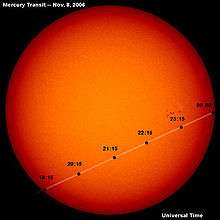 | 18:12 | 20:41 | 23:10 | [39] | |
2016 May 9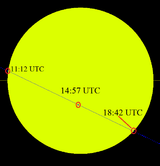 | 11:12 | 14:57 | 18:42 | 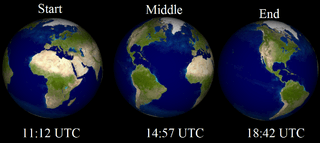 | |
| Future transits of Mercury | |||||
|---|---|---|---|---|---|
| Date of mid-transit | Time (UTC) | Notes | |||
| Start | Mid | End | |||
2019 Nov 11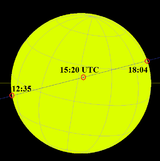 | 12:35 | 15:20 | 18:04 | 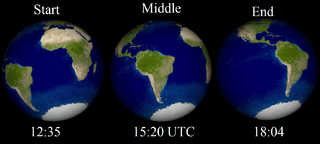 | |
| 2032 Nov 13 | 06:41 | 08:54 | 11:07 | ||
| 2039 Nov 7 | 07:17 | 08:46 | 10:15 | ||
| 2049 May 7 | 11:03 | 14:24 | 17:44 | ||
| 2052 Nov 8–9 | 22:53 | 01:29 | 04:06 | ||
| 2062 May 10–11 | 18:16 | 21:36 | 01:00 | ||
| 2065 Nov 11–12 | 19:24 | 22:06 | 01:48 | ||
| 2078 Nov 14 | 11:42 | 13:41 | 15:39 | ||
| 2085 Nov 7 | 11:42 | 13:34 | 15:26 | ||
| 2095 May 8–9 | 17:20 | 21:05 | 00:50 | ||
| 2098 Nov 10 | 04:35 | 07:16 | 09:57 | ||
| 2108 May 12 | 01:40 | 04:16 | 06:52 | ||
| 2111 Nov 14–15 | 22:15 | 00:53 | 03:30 | ||
| 2124 Nov 15 | 16:49 | 18:28 | 20:07 | ||
See also
References
- Cunningham, Clifford J., "Mercury's Time to Shine," Mercury Sep–Oct 2006.
- 1 2 Webster, Guy (June 10, 2014). "Mercury Passes in Front of the Sun, as Seen From Mars". NASA. Retrieved June 10, 2014.
- ↑ Transits of Venus
- 1 2 Newcomb S, APAE Vol 1, 1882, from page 367
- ↑ Morrison LV and Ward CG, Royal Greenwich Observatory Bulletin No.181, 359-420 (1975)
- ↑ Innes RTA, (1925) Union Obs Circ, No. 65
- ↑ Spencer Jones H, (1939) MNRAS 99, 541
- ↑ Morrison LV & Ward CG, (1975) MNRAS 173, 183
- ↑ Morrison LV, Parkinson, & Stevenson, Nature, 288, 548-551 (1980)
- ↑ Sigismondo C http://www.icra.it/gerbertus/2016/Gerb-9-2016-Sigismondi-transito-83-86.pdf
- ↑ "Schneider G, Pasachoff Jay M, & Leon Golub L, (2004), "TRACE Observations of the 15 November 1999 Transit of Mercury and the Black Drop Effect: Considerations for the 2004 Transit of Venus," Icarus 168, 249-256" (PDF).
- ↑ Pasachoff, Jay M., Glenn Schneider G, & Golub L, 2003, "Space Studies of the Black Drop Effect at a Mercury Transit," IAU01082, presented at the Joint Discussion on Mercury, Sydney General Assembly of the International Astronomical Union, #1204, p. 156.
- ↑ Pasachoff Jay M., & Sheehan B, (2012), "Lomonosov, the Discovery of Venus's Atmosphere, and Eighteenth-century Transits of Venus," Journal for the History and Heritage of Astronomy 15 (1), RP1, 1-12.
- ↑ Pasachoff, Jay M., Schneider G & Willson RC, (2008), "Total Solar Irradiance at the 2006 Transit of Mercury and Application to Transiting Exoplanet Observations," Cornell DPS Meeting; abstract: Bull. Am. Astron. Soc., 40, #3, 404.
- ↑ Nemiroff, R.; Bonnell, J., eds. (19 November 1999). "Mercury And The Sun". Astronomy Picture of the Day. NASA.
- ↑ Nemiroff, R.; Bonnell, J., eds. (11 May 2016). "A Mercury Transit Music Video from SDO". Astronomy Picture of the Day. NASA.
- ↑ Nemiroff, R.; Bonnell, J., eds. (12 May 2016). "A Transit of Mercury". Astronomy Picture of the Day. NASA.
- ↑ Nemiroff, R.; Bonnell, J., eds. (13 May 2016). "ISS and Mercury Too". Astronomy Picture of the Day. NASA.
- ↑ Newcomb S, APAE, Vol 1 (1882), pp 477-487
- ↑ Crommelin P, The Observatory, Dec 1894, pp394-397
- 1 2 {http://eclipse.gsfc.nasa.gov/transit/catalog/MercuryCatalog.html, Espenak}
- ↑ http://www.solexorb.it/SolexOld/ SOLEX
- 1 2 Walker, John. "Quarter Million Year Canon of Solar System Transits". fourmilab.ch.
- ↑ "1999 Transit of Mercury". nasa.gov. Retrieved 25 August 2015.
- ↑ "The November 15, 1999 Transit of Mercury". astroleague.org. Retrieved 25 August 2015.
- 1 2 3 4 5 6 7 8 9 10 11 12 13 14 15 16 17 18 19 20 21 22 23 "Seven Century Catalog of Mercury Transits: 1601 CE to 2300 CE". NASA.
- ↑ Chapman, A. (1985), Transactions of the Historical Society of Lancashire and Cheshire Volume 135 pp 1–14
- ↑ Eric G. Forbes et al. (1995), Correspondence of John Flamsteed Volume 1, Institute of Physics Publishing, p. 624–627
- ↑ Wayne Orchiston 1994, James Cook and the 1769 Transit of Mercury, Carter Observatory ISSN 1173-7263 https://books.google.com.au/books/about/James_Cook_and_the_1769_Transit_of_Mercu.html?id=v-wAMwAACAAJ&redir_esc=y
- ↑ "The Monthly magazine. v.7 (1799). - Full View | HathiTrust Digital Library | HathiTrust Digital Library". babel.hathitrust.org. Retrieved 2017-07-04.
- ↑ Magazine of Popular Science, and Journal of the Useful Arts, Volume 3 p.154
- ↑ "The Monthly magazine. v.14 (1802). - Full View | HathiTrust Digital Library | HathiTrust Digital Library". babel.hathitrust.org. Retrieved 2017-07-04.
- ↑ "1960 Transit of Mercury". HM Nautical Almanac Office. UK Hydrographic Office. November 5, 2007. Retrieved May 30, 2012.
- ↑ "1970 Transit of Mercury". HM Nautical Almanac Office. UK Hydrographic Office. November 5, 2007. Retrieved May 30, 2012.
- ↑ "1973 Transit of Mercury". HM Nautical Almanac Office. UK Hydrographic Office. November 5, 2007. Retrieved May 30, 2012.
- ↑ "1986 Transit of Mercury". HM Nautical Almanac Office. UK Hydrographic Office. November 5, 2007. Retrieved May 30, 2012.
- ↑ "1993 Transit of Mercury". HM Nautical Almanac Office. UK Hydrographic Office. November 5, 2007. Retrieved May 30, 2012.
- ↑ "1999 Transit of Mercury". HM Nautical Almanac Office. UK Hydrographic Office. November 5, 2007. Retrieved May 30, 2012.
- ↑ "2003 Transit of Mercury". HM Nautical Almanac Office. UK Hydrographic Office. November 5, 2007. Retrieved May 30, 2012.
- ↑ "2006 Transit of Mercury". HM Nautical Almanac Office. UK Hydrographic Office. November 5, 2007. Retrieved May 30, 2012.
- ↑ "The Transit of Mercury on 2016 May 9". Retrieved June 7, 2012.
External links
| Wikimedia Commons has media related to Transit of Mercury. |
| Wikimedia Commons has media related to 2016 Transit of Mercury. |
- NASA: Transits of Mercury, Seven Century Catalog: 1601 CE to 2300 CE
- NASA Astronomy Picture of the Day: NASA: Image from the transit of Mercury in 2003 (27 May 2003)
- Shadow & Substance.com: Transit of Mercury Animated for November 8, 2006
- Transits of Mercury – Fourteen century catalog: 1 601 AD – 3 000 AD
- Transits of Mercury on Earth – Fifteen millennium catalog: 5 000 BC – 10 000 AD
- Scroll a little bit down and then click on 40540. You will get then a table from −125,000 till +125,000.
- Time Lapse of the 9th May 2016 Transit of Mercury
- Links to high-resolution video from a major solar telescope and more about several transits
